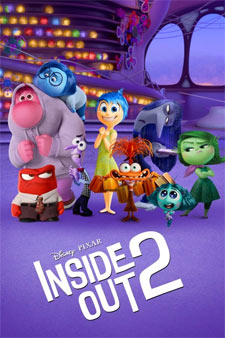
Inside Out 2

 – for some thematic elements.
– for some thematic elements.
Director: Kelsey Mann
Starring: voices of Amy Poehler, Maya Hawke, Kensington Tallman, Tony Hale, Phyllis Smith, Lewis Black, Diane Lane, Kyle MacLachlan
Running Time: 1 hour, 36 minutes
Theatrical Release Date: June 14, 2024
Digital Release Date: August 20, 2024 (Prime Video)
Plot Summary
Follows Riley, in her teenage years, encountering new emotions. (from IMDB)
Film Review
While Hollywood is all about sequels and franchises, it still can be a little surprising for certain films that didn’t immediately seem like it warranted a sequel to eventually get one. With Pixar’s Toy Story being pretty much a no-brainer, and Cars or The Incredibles also seeming ripe for further exploration, it may still be kind of surprising that we got a prequel for Monster’s Inc. or a sequel to Finding Nemo. Enter Inside Out. The 2015 original was a beautiful and amusing look at emotions inside the mind of a young child, but I can’t say anyone ever really expected a sequel to it. However, Inside Out 2 is the perfect example of what a worthwhile sequel can be. Once we realize it’s about the challenges of the same young girl from the first movie now entering puberty, one has to wonder why it took nine years for this sequel to become a reality.
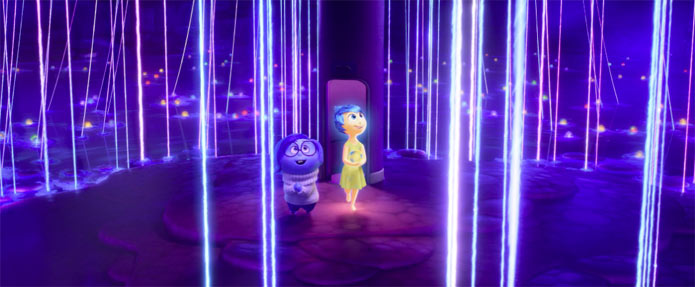
The emotion characters of Joy, Sadness, Fear, Disgust and Anger all return to the mental console behind little Riley’s eyes, but just like a maturing human can be blindsided by unexpected new feelings and emotions, our lovable quintet is suddenly faced with a whole new team: Anxiety, Embarrassment, Envy and Ennui (Boredom). They literally take over and overwhelm what drives our Riley as she navigates being 13 years old and trying to find how and where she fits in. She’s also got all the relatable situations of a budding teenager too: a hero she emulates in a high school hockey star, close friends that don’t really fit in with the “cool kids,” insecurity over her abilities and talents, and the struggle to do the right thing in every situation. As Riley is trying to figure this all out, the original 5 emotions are also trying to figure out what all of this means, coming nose-to-nose with that age-old question: What does it mean to grow up?
Inside Out was one of those animated kids movies that wasn’t really for kids. Navigating emotions at any stage of life is a complex feat, and the movie ended up being just as relevant for adults as it was for its intended audience (After all, how cute is Joy, Sadness, Fear, Disgust and that oddly lovable Anger?). Inside Out 2 may even more so not be intended for kids. While the movie focuses on the life and feelings of a 13-year-old girl, it can be expected to help those around that same age see that what they’re wrestling with is a common thing among youth their age. However, it’s all viewed through the lens of an adult. Adults write, direct, voice and animate these movies, and many of them are parents themselves. So as we see Riley confronted with the frantic good intentions of something like a personified version of Anxiety, any adult who’s struggled with this can certainly relate. And as we visually see Riley basically take on her first “anxiety attack,” it’s hard – as an adult – to not get emotional about seeing this illustrated in a way that “gets” you. It’s not hard to visualize ourselves in Riley’s shoes end empathize with her.
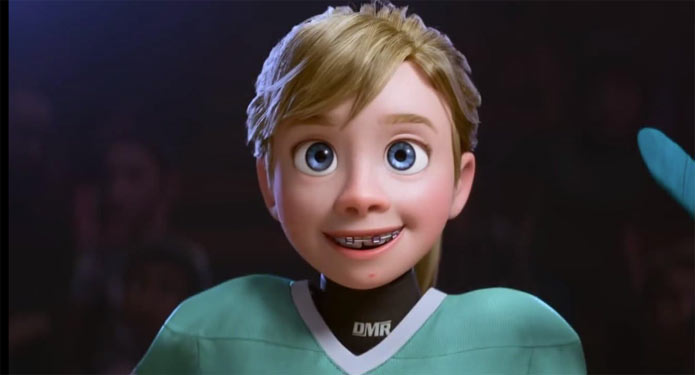
Inside Out 2 may be a sequel, but it feels like a natural continuation of the first film and doesn’t fall prey to sequelitis where it just largely feels like a retread of the first movie. Sure, there are kind of “references” to the first movie, but only in an organic way; it feels like the next “episode” and not a nostalgia trip (Something the movie pokes fun at in an adorable, brilliant, and hilarious way, by the way). While little kids probably may find the movie a bit heavy for them at times, anyone who’s struggled with emotions (big and small) will most appreciate the film. Joy, as expected, just wants the best for Riley, and finds a hard time knowing how to accomplish this with things like Anxiety and Envy in the picture. This is, once again, very much Joy’s story as she tries to “save” Riley from these new emotions. But what’s interesting is, while some may see all of the new types of emotions as evil or sinful (like envy or the worrying that drives anxiety), the movie portrays how these emotions can be utilized and controlled in a healthy manner — to the point where anyone who’s ever experienced therapy will recognize techniques being used and illustrated that can help anyone manage these tricky feelings. Inside Out 2 is a truly complex affair, and it will most certainly allow for some worthwhile discussions among friends and family after the credits roll (which, by the way, have a cute after-credits scene that’s worth sticking around for, by the way).
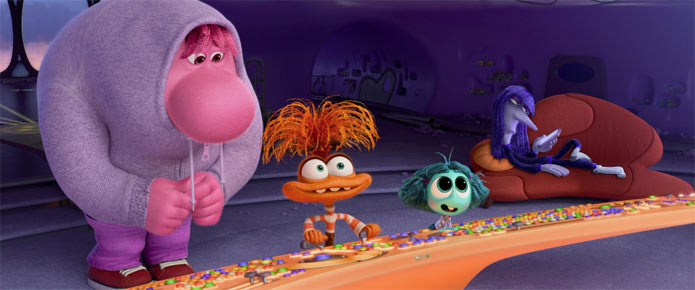
The content for Inside Out 2 is relatively tame, and pretty much in line with the first movie. While 2015’s Inside Out made references to Anger swearing (covered up by bleeps and such), all of that is absent here. The only semi-profanity is more of a suggestive substitution where Joy exclaims “mother lovin'” in a frustrated moment. And despite Disney’s shameless and relentless agenda-pushing these days, there’s actually nothing present that continues or adds to this agenda, thankfully. Inside Out 2 pretty much has kids and families in mind here, and it doesn’t go unnoticed or unappreciated. There’s a little violence, specifically hockey-related action that involves the kids, and some of the rough-handling between the emotions, and related peril as the original team of 5 emotions band together to try to help Riley.
The voice talents employed here are all solid – with Amy Poehler’s Joy and Phyllis Smith’s Sadness continuing to be truly inspired casting choices. And if you’ve ever seen Maya Hawke’s performance as Robin in Stranger Things, she really seems like an obvious choice for Anxiety, and she does an incredible job here. While everyone else is also good, I can’t help but wonder why Bill Hader didn’t return as Fear and Mindy Kaling didn’t reprise her role as Disgust. Both were great in the 2015 film, so while their replacements here are fine, I did especially miss Kaling this time around. (Tony Hale did a pretty great job taking over as Fear, though, I must say.)
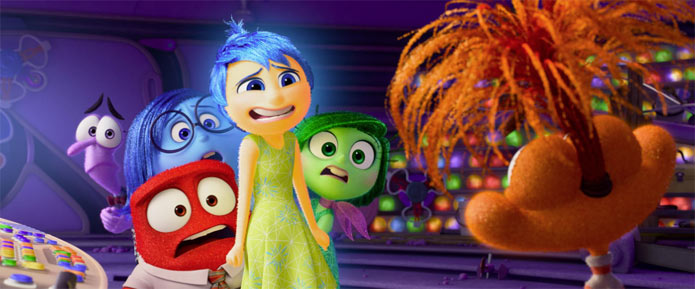
In recent years, movies like Wreck-It Ralph or any of the Spider-Verse movies have been utilizing a blend of animation styles with fantastic results. Here, Inside Out 2 makes use of this a couple times in small doses, creating some of the funniest moments in the entire film. Without spoiling anything specifically, I’ll just say that kids can definitely relate to these references, while parents will especially love a brilliant and clever nod to a popular Disney show for little kids in a way that is wholly relatable (in an oddly therapeutic way, too). As heavy and serious as Inside Out 2 can be, it still manages to have plenty of humor and fun moments along the way. It may be too “heavy” to want to revisit on a regular basis, but after one viewing, I’m already looking forward to seeing it again.
Inside Out 2 is the perfect example of a sequel done right. It’s been a while since I’ve seen the first film, but I’m tempted to say this second entry may be better than the original. It’s a good movie for the whole family, but the younger ones may either not understand the complex and dramatic things Riley is going through. However, they also might look past it to just enjoy the cute emotion characters and fantastic animation. With the absolutely wonderful IF having preceded this one a month earlier, it’s a summer for big feelings, and Inside Out 2 is an excellent addition to your summer entertainment – and a delightful return to form for Pixar.
– John DiBiase (reviewed: 6/14/24)
iTunes / Digital Copy Bonus Features
Pixar’s sequel to 2015’s Inside Out is now available for home or on-the-go viewing. While it’s not available in physical media form just yet (and can probably still be found running in some theaters right now), the movie is given a solid digital 4K home release. Obviously, Pixar’s animation quality only improves with each feature they deliver, and Inside Out 2 is no exception. The 4K transfer is as vibrant as you’d hope it to be, so it doesn’t disappoint.
The special features on the AppleTV digital copy include:
New Emotions (11:44) – The film’s director, Kelsey Mann, is accompanied by psychologists as they talk about the impact of puberty on kids and the overwhelming shift in emotions for young teens. Here, we learn that the production team originally planned for nine new emotions to be added to the group, but realized it was too much and had to whittle it down to four. The featurette then focuses on the creation of each new emotion character, starting with Anxiety and continuing with Embarrassment, Envy and Boredom (AKA Ennui).
Unlocking the Vault (8:59) is all about the “vault” that the hero emotions are locked in, and the things also hidden inside. The director and animators sit in a small screening room and discuss the challenges of the art direction for each character within the vault and their different animation styles.
Deleted Scenes (23:56) – There are five deleted scenes with a Play All option. Each one is presented in rough, storyboard format and features introductions by the director, Kelsey Mann. Almost all of these ideas were conceived during the early process of the story creation, so most wouldn’t have fit into the final film as it is.
- Cold Open (2:08) – The original opening for the movie was supposed to take place at a talent show where Riley tries to perform a song. The film team ditched the idea to focus on Riley’s love of hockey.
- Broken Joy (3:30) – Joy struggles with not being able to use the console to help influence Riley’s emotions. We then see the emotions in their bedrooms at night.
- Pool Party (8:58) is a cringy scene involving teenage awkwardness. In this sequence, Riley and her friends go to a pool party with their peers and it turns into a disaster. The version of Anxiety used here morphs into a much more evil version of her character, otherwise known as Self-Loathing. They decided to change the character to always be trying to love and protect Riley instead.
- Puberty Park (4:47) – The emotions end up in an amusement park called Puberty Park, with fun ideas connecting carnival rides to the experience of puberty, but the filmmakers couldn’t figure out how to connect it to Riley’s life outside her head, so they scrapped the concept.
- Shame Spiral (4:33) – In this sequence, a group of teens are playing the game “Never Have I Ever,” and it was the original climax for the movie, but they decided to focus on Anxiety and not the addition of a Shame character.
– John DiBiase (reviewed: 8/23/24)
Parental Guide: Content Summary
![]() Sex/Nudity: None.
Sex/Nudity: None.
![]() Vulgarity/Language: 1 “mother lovin'” (as “Jiminny mother-loving toaster strudel!”)
Vulgarity/Language: 1 “mother lovin'” (as “Jiminny mother-loving toaster strudel!”)
![]() Alcohol/Drugs: None.
Alcohol/Drugs: None.
![]() Blood/Gore: In one anxious-induced imagined scenario, Riley is briefly shown as a skeleton with clothes on, sitting on a bench, as her bones slump over.
Blood/Gore: In one anxious-induced imagined scenario, Riley is briefly shown as a skeleton with clothes on, sitting on a bench, as her bones slump over.
![]() Violence: Some of the emotions are taken captive and literally “bottled up” and locked away at one point; A group of “mind police” chase and try to apprehend the main emotions; A character rolls down a hallway, causing several of the police officers to stumble over each other accidentally lock themselves in a vault; An emotion is seen being sucked up a clear tube forcefully; Part of the “ground” in Riley’s mind collapses to form a “sar-chasm”; A “brainstorm” sweeps up the emotions and we see them struggling as they whirl wildly around in a storm and try to escape it; An avalanche of memory balls sweep some characters away and over a cliffside; Riley trips another girl player during hockey and we see it again in memory playback a couple times; Riley slams into another girl on the ice during a hockey game, knocking her down (The other child is a little hurt, but not seriously); Dynamite is used to get out of a situation; A cartoon character has helpful objects inside of it. At one point, Anger shoves his arm inside of its mouth roughly (played for laughs); Riley experiences an anxiety attack, breathing heavily and gripping her chest; And some other cartoon-style violence.
Violence: Some of the emotions are taken captive and literally “bottled up” and locked away at one point; A group of “mind police” chase and try to apprehend the main emotions; A character rolls down a hallway, causing several of the police officers to stumble over each other accidentally lock themselves in a vault; An emotion is seen being sucked up a clear tube forcefully; Part of the “ground” in Riley’s mind collapses to form a “sar-chasm”; A “brainstorm” sweeps up the emotions and we see them struggling as they whirl wildly around in a storm and try to escape it; An avalanche of memory balls sweep some characters away and over a cliffside; Riley trips another girl player during hockey and we see it again in memory playback a couple times; Riley slams into another girl on the ice during a hockey game, knocking her down (The other child is a little hurt, but not seriously); Dynamite is used to get out of a situation; A cartoon character has helpful objects inside of it. At one point, Anger shoves his arm inside of its mouth roughly (played for laughs); Riley experiences an anxiety attack, breathing heavily and gripping her chest; And some other cartoon-style violence.
